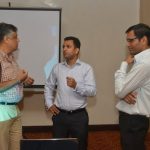- October 30, 2013
- Posted by:
- Category:BLOG, Events, Mumbai, Speaker Events
Contributed by: Chetan Shah CFA
IAIP organised a speaker event on Indian Agribiz Industry in Mumbai on October 25th wherein Ravishankar Mantha, Founder Director, AgRisk, gave a good perspective of the agriculture industry, ironies, factors at play and where it could go into the future. The event was well received by the members. The following are the excerpts of this event.
The present world population of 7.0bn people is estimated to reach 9.1bn by 2050. To support the same the present cereal production of 2.1bn MT needs to increase to 3.0bn MT and meat production from 200mn MT to 470mn MT. These during times when the area under cultivation is shrinking due to diversion of limited land to energy crops like maize used for production of ethanol (for blending with gasoline).
The Green Revolution increased investment in the agriculture sector and hence crop production in India. However, post liberalisation not much investment has gone into agriculture. The Green Revolution also had led to heavy use of chemicals (fertilisers and pesticides) leading to deterioration of soil and increased cases of cancer especially in state like Punjab.
India is amongst the top 2 producer of grains, sugar, tea and milk etc. Yet it forms 1.6% of global food trade. Most of it is consumed internally.
The food processing and value addition as proportion of agriculture is just 6% for India compared to 21% for Brazil, 30% for Thailand and 53% for the USA. These could be partly be explained by the habits of Indians to have freshly cooked food or fruit juices; though milk has changed the dynamics.
Post-harvest the food wastage is estimated at 25% of the produce. This is large especially when nearly 130mn people go hungry each night.
According to Ravi MSPs on most crops are likely to stay high as the costs at the farm gate have increased. Thanks to MSPs the production of crops like pulses has increased.
There are number of factors for the increase in costs the major being NREGA (National Rural Employment Guarantee Act) which has resulted into migration of labour from farm lands to urban and semi-urban areas and thereby shortage of labour for cultivation. The marginal land holdings further make agriculture production economically unviable.
Farmers are well informed about prices, crop rotation, yields, economics per acre etc. The farmer, lender, agent network is very strong. It is very difficult to break their ecosystem. Ravi expressed doubts in organised retailers’ ability about direct procurement, removing the middlemen and bringing the prices down.
The big opportunities and plans of having mega food parks, integrated cold chains, training facilities, joint research laboratories, quality control centres, customized farm equipment etc. have all remained so on paper. Nothing has moved ahead over the last decade. The gestation period is high and investors’ risk appetite low.
Tractor sales have been good this season. It is used for both agriculture and non-agriculture (like transport of bricks, cement for construction activities during off-season). There are villages where tractors & tillers are leased during season. Mechanisation and standardisation has not happened in the country.
According to Ravi government should be careful while allowing genetically modified crops as it could disrupt natural plant communities and other ecosystem. Also there are reports of violation of India’s Biological Diversity Act like in case of Bt Brinjal.
You could click on the following link for a copy of the presentation http://www.cfasociety.org/india/Pages/ContinuingEducation-Presentations.aspx























